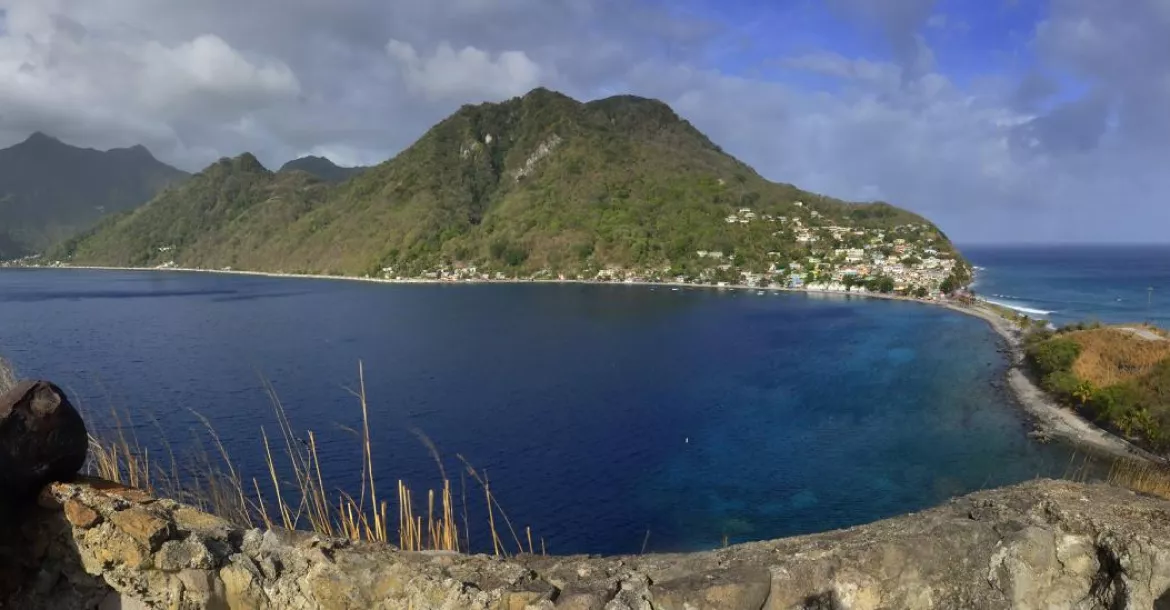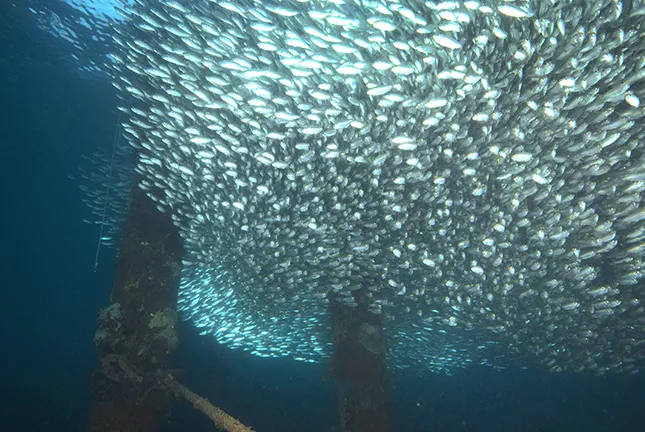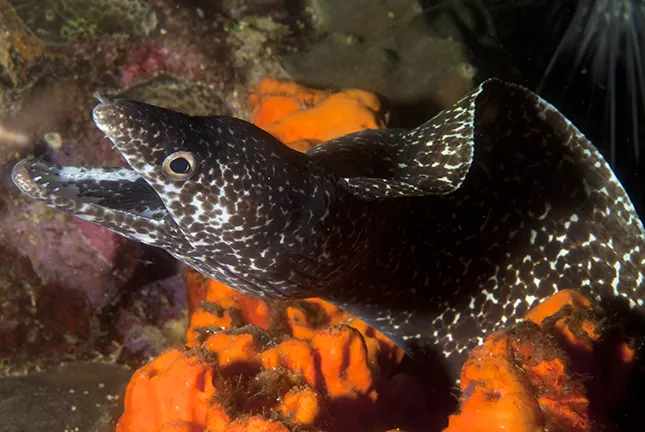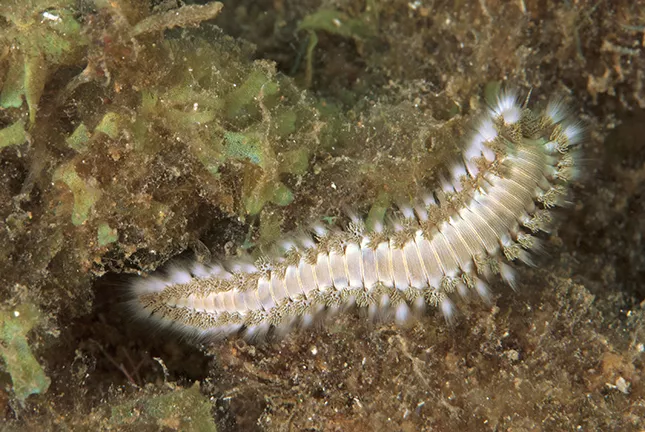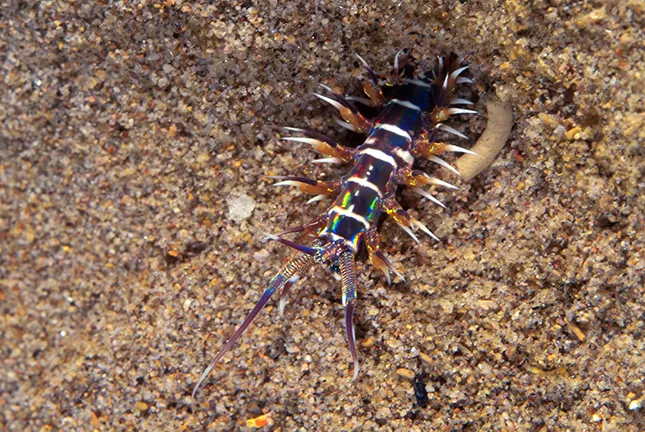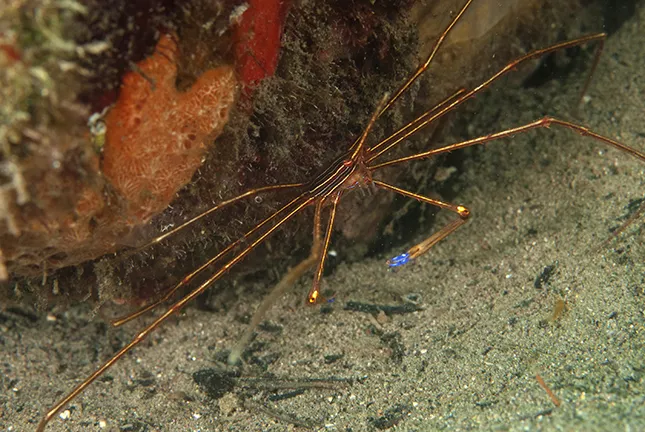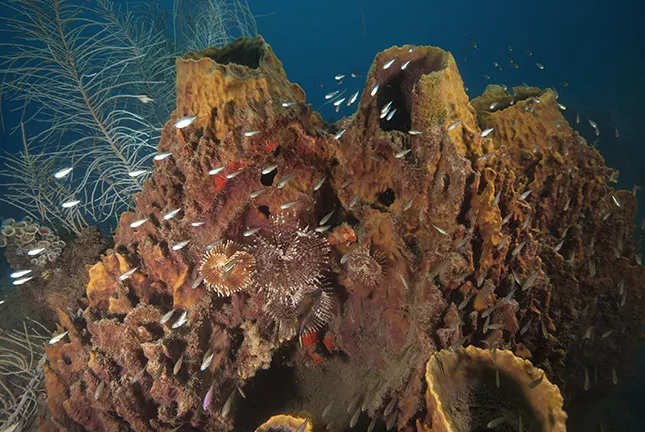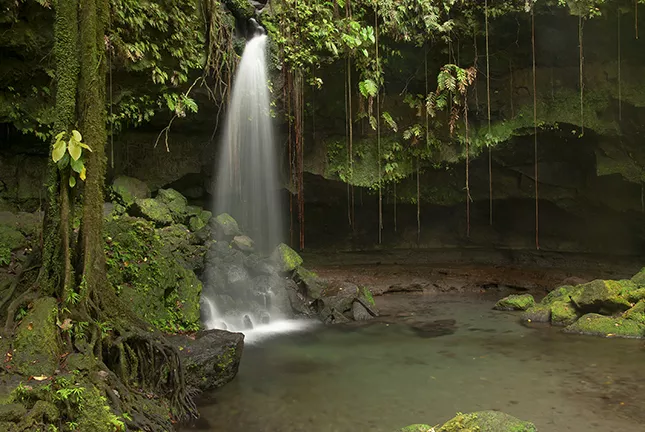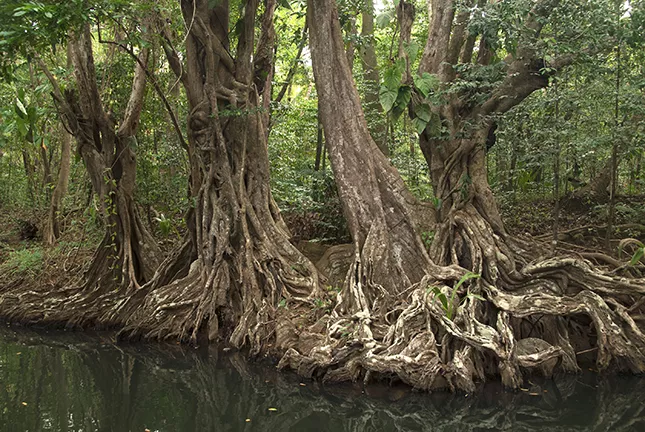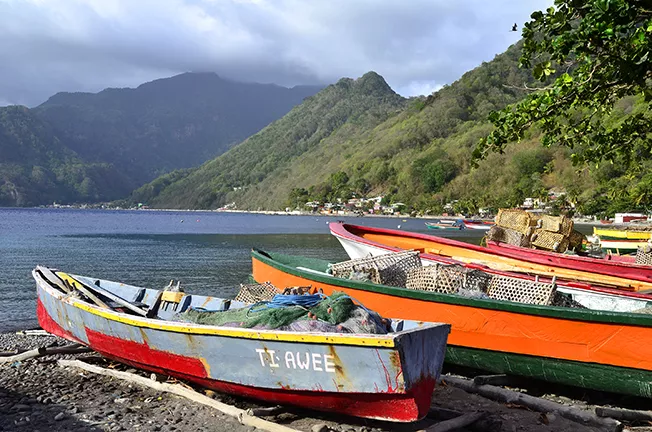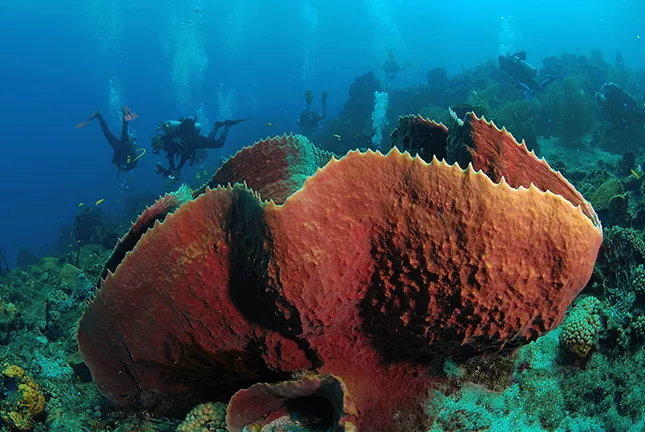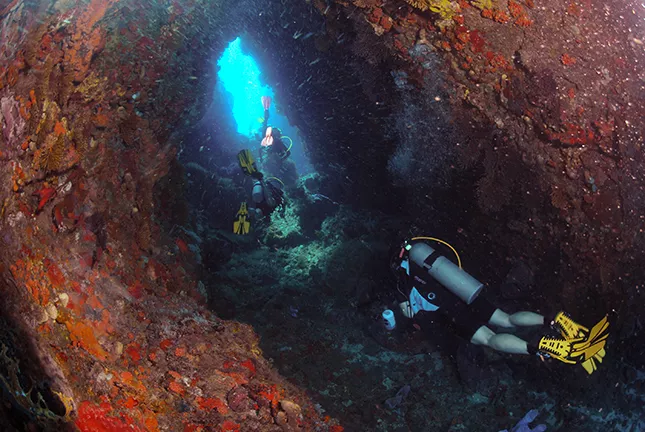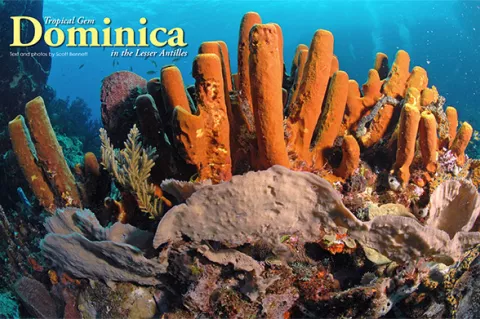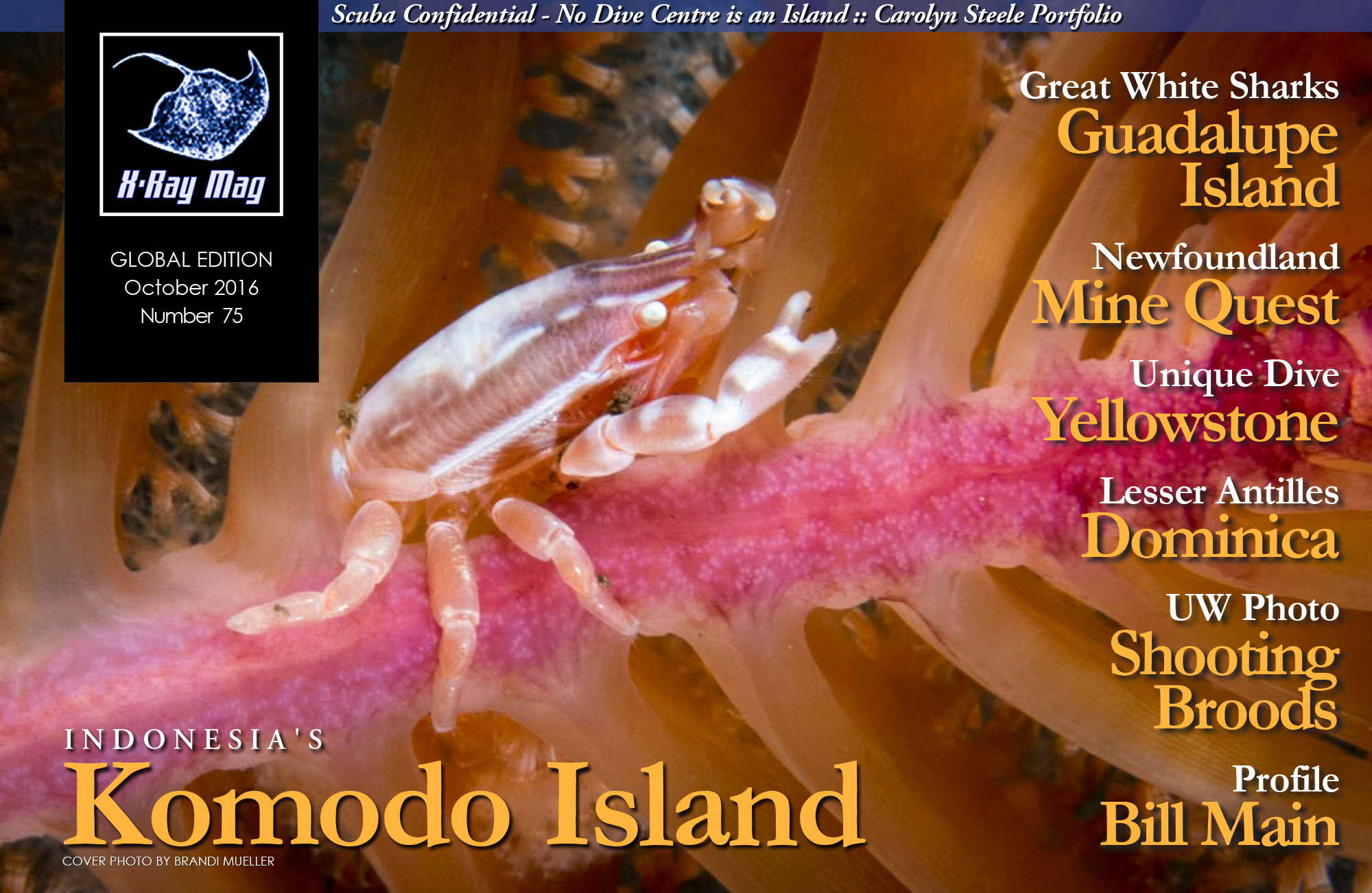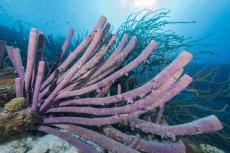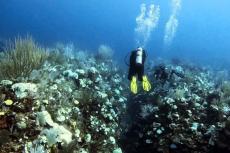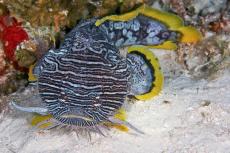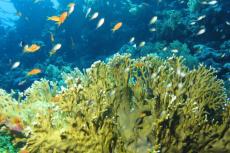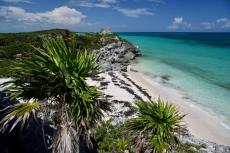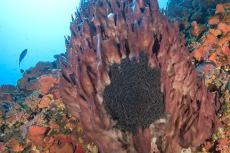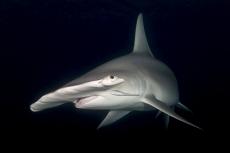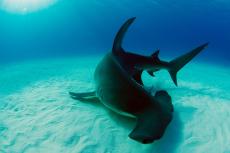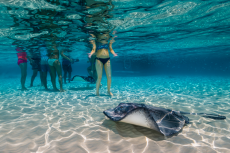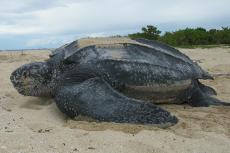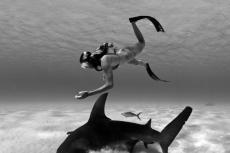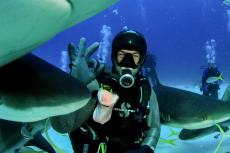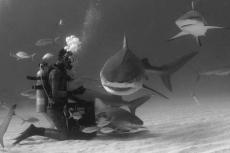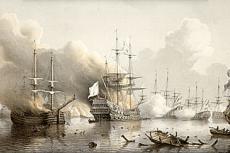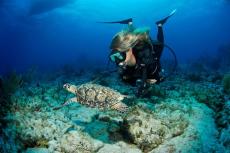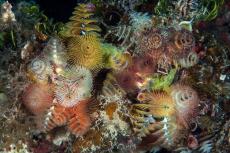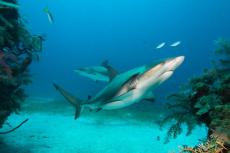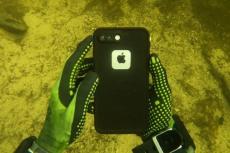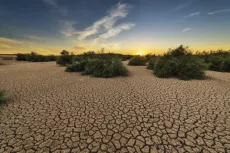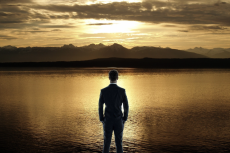“Not the Dominican Republic, Dominica,” I corrected my friends for the umpteenth time regarding my upcoming trip. Then again, it was easy to understand how the gaffe had come about. While the former is home to sprawling resorts and package tourism, the latter is a tropical gem in the Lesser Antilles which is a far cry from its similarly-named Caribbean cousin. Billing itself as the Nature Island, its relative obscurity, compact size and pristine beauty make for a nature-lover’s Shangri-La.
Contributed by
Factfile
HISTORY OF DOMINICA
Dominica was discovered on 3 November 1493 by Christopher Columbus, naming it Sunday (“dies Dominica” in Latin) after the day he found it. At the time, it was inhabited by the Kalinago people. For the ensuing century, Dominica remained off the beaten path.
Fierce Kalinago resistance combined with the island’s isolation hastened the departure of the Spanish. France had a colony for a number of years and imported African slaves to work the plantations. It was during this period that the Antillean Creole language developed. In 1763, France ceded Dominica to Great Britain, who established colony in 1805. The French retook the island in 1778, only to hand it back in 1783 as a concession in the Treaty of Versailles.
Slavery was abolished throughout the British Empire in 1834 and by 1838, became the first British Caribbean colony with an ethnic African majority-controlled legislature. In 1896, the island became a British Crown colony and on November 3rd, 1978, an independent nation. Today, Dominica is the last stronghold of the Kalinago people, whose numbers total around 4500.
Make no bones about it—there is no quick and easy way to get there. Despite being in the same hemisphere as my home in Toronto, getting to Dominica proved to be a full-day expedition. Arriving at the airport at 5:30 a.m. on a Sunday morning, there was no queue and I was at the gate in 20 minutes flat. Fortunately, I squeaked through Air Canada’s stringent new carry-on baggage limitations. To ensure there were no hassles, I stuffed my pockets with batteries, cords and chargers to play it safe!
Arriving in Antigua, I had to collect my bags, go through immigration, check in again at the LIAT counter and go right back through immigration. This time, I was hit with a US$60 charge for the second bag as opposed to the CA$25 in Toronto. When it comes baggage rules, there is no logic! My final flight was only 30 minutes, including a brief stop in Guadeloupe, its high rises and modern airport in stark contrast to Antigua.
Arriving just after 8 p.m., I grabbed my bags and ventured outside to arrange for a taxi to take me to Castle Comfort Lodge on the outskirts of Roseau, the island’s capital. I was perplexed to learn that the trip would take 70 minutes. After all, wasn’t the island only 29 miles long by 16 miles wide? It turns out that there was a very good reason for it. Heading inland, the road zigzagged as we traversed the island’s mountainous spine. The indigenous Carib people named the island Waitikubuli, which means “tall is her body.” And a tall lady she is. Despite its compact proportions, the island is the Caribbean’s most vertical, with rugged forest-clad peaks encompassing its entire area.
With yellow reflectors on the centerline, it was reassuring to see where the road actually was, considering the absence of streetlights and my driver’s excessive speed. After relentless hairpin turns, Roseau’s twinkling lights came into view. I discovered that Castle Comfort was actually the name of a small suburb outside the city. After checking in, I discovered the restaurant was still open, so I headed over there for a bite. Best of all, no jetlag!
Diving
The next morning after breakfast, I checked in at Dive Dominica to prepare for the morning’s diving. Adjoining the lodge, the dive center is one of the island’s oldest. On hand to meet me was divemaster Imran Pacquette, who quickly got me set up with the gear. The other divers were a mixture of Americans and fellow Canadians.
With everyone ready, we set out for Soufrière Scott's Head Marine Reserve, located nearby in the southwest of the island. Dominica’s coastlines have a decidedly opposing character. The eastern side is pounded by the Atlantic’s crashing surf while the western shore faces the more tranquil Caribbean waters. Most dive sites are found along the Caribbean side.
Swiss Cheese. It is always exciting to dive at a new location in a new country, and Dominica didn’t disappoint. Our first site was Swiss Cheese, part of the Scott’s Head pinnacle complex and named for the maze of nooks, crannies and swim-throughs carved into the reef. Visibility was astounding, and easily exceeded 40m; it was one of the few instances where I have encountered such clarity in over 20 years of diving. Descending below 20m, Imran led us through a swim-through jam-packed with blackbar soldierfish and grunts. Swimming above the reef, I marveled at the diversity and colors of the corals and sponges. Although I didn’t see any barracuda, they are sometimes encountered here.
L’Abym. For the surface interval, we headed for Soufrière village. Anchoring offshore, we admired the local church’s colorful steeple. Next door, a sign proclaimed “Bubble Beach Spa”; however, deck chairs facing a stony beach made for one odd-looking spa. Then, once the interval was up, a short boat ride brought us to L’Abym. Translated as “abyss” in the local Creole dialect, the name couldn’t have been more apt!
Encompassing the eastern edge of Soufrière crater, the site’s distinguishing feature is an immense wall that plummets 500m from the cliffs above. From the mooring line, an easy descent led to a sandy shelf at 8m, the bottom punctuated with rocky outcrops teeming with sponges and sea fans. On one sponge, Imran pointed out a pair of frogfish. Having done most of my diving in the Pacific, I was unaware that frogfish even live in the Caribbean.
We then headed for the wall and it was truly spectacular. The array of sponges was extraordinary. Clusters of yellow tube sponges jutted from the walls, along with rope, tubulate and pink vase sponges. Almost electric in intensity, enormous orange elephant ear sponges glowed against the deep blue of the open water beyond. Wedged between a pair of tube sponges, a seahorse peered out, almost in defiance of being photographed. Plate, finger and knobby brain corals, black coral trees and gorgonians jostled for space on the seemingly endless wall. First days just don’t get much better.
Delicious dishes
Returning from the dive, I had lunch at the Evergreen restaurant next to my hotel. I started with a tamarind juice, pleasantly tangy with a bit of sugar to mute the tartness. My main course of braised lionfish with a Creole coconut sauce was very tasty indeed. I was happy to do my part towards lionfish eradication!
Served alongside my meal were side dishes listed as “provisions”. Although I initially visualized a canteen and flares, they are in actuality local roots such as dasheen (taro), yams or potatoes served along with plantains or rice (or sometimes both). Although I didn’t get to sample it, Dominica's national dish is the mountain chicken. However, this chicken isn’t avian but amphibian, being a frog called the crapaud. Endemic to Dominica and Montserrat, it is a protected species that can only be caught between autumn and February.
Scott’s Head Peninsula
After lunch, I went on a land tour to the Scott’s Head area. My driver was Martin Tarvenier, a friendly, soft-spoken fellow with an impressive set of waist-length dreadlocks. We were supposed to stop for a snorkeling tour at Champagne Reef, named for the stream of bubbles ascending from submerged gas vents called fumaroles. Running late, we opted to head straight for the Scott’s Head Peninsula instead.
En route, each turn revealed another spellbinding view and I had to resist the urge to ask Martin to constantly stop for photos. It turns out that divers and nature lovers are not the only ones lured by the island’s natural bounty; Hollywood has also come a-calling, most notably in 2005 for the movie "Pirates of the Caribbean: Dead Man’s Chest". A number of key sequences were filmed on the island, one of which featured Johnny Depp’s Captain Jack Sparrow battling cannibals on a suspension bridge.
Approaching Soufrière, Martin indicated a section of road where steep cliffs ascended on either side. “This is where they constructed the suspension bridge for the film,” he said. During filming, traffic passed beneath and on one occasion, he had seen Depp fully garbed in pirate attire crossing high above. Both cast and crew mingled with the residents, attending a number of island events.
We soon arrived in Soufrière, an appealing jumble of colorful houses framed with lush tropical vegetation. It was also Martin’s hometown where he seemed to know everyone, cheerily greeting friends and relatives every few meters. Just down the road was Scott’s Head, named after Colonel George Scott, a participant in the British invasion that seized Dominica from the French in 1761, and who later became lieutenant governor from 1764 to 1767.
We then crossed a narrow isthmus connecting the headland to the rest of Scott’s Bay. Although it looked man-made, Martin assured me it was a natural formation. A steep ascent led to a lookout offering magnificent views over Scott’s Head village and its entire bay. A corroded old cannon was the only indication that this had once been a fort, as most of the structure had collapsed into the waters below long ago.
Heading back, we stopped at Soufrière Village for a visit to the aforementioned Bubble Beach Spa and my earlier bewilderment was promptly cleared up. There was a wall of rocks enclosing a small pool alongside the shoreline where a sulfur spring bubbled up from beneath the sand. I only waded in till the water was up to my knees. Although it was hot, it was not scalding. Still, a half-hour immersion would certainly have left me well-done.
More diving
Dangleben’s Pinnacles. The next day saw a return to Soufrière but there were no complaints from me. First up was Dangleben’s Pinnacles. Named after the Dangleben family that owned the adjacent land, the site consists of five pinnacles ascending from the Soufrière crater’s northern edge. Ascending to within nearly 8m from the surface, they descend to a base shelf at 18m, creating a topographical labyrinth that is home to a myriad of fish species. When the current is running, schools of jacks, creole wrasse, yellowtail snappers and barracudas can be seen.
While gearing up, I noticed that one of the Canadian guys had a rather surprising accessory. Although spear guns would be considered unwelcome in most places during a dive trip, it was an entirely different matter here. His quarry was the Caribbean’s most unwelcome visitor: lionfish. After their accidental release in Florida back in the ‘90s, the lionfish numbers have exploded, with populations engulfing the entire Caribbean. Dominica has initiated a practical solution: If you can’t beat ‘em, eat’em! Lionfish are now prominent on many a restaurant menu in Dominica and a case in which all-you-can-eat is not an environmental hazard.
Although large pelagics were absent due to the mild current, there was fish life in abundance including French angelfish, princess parrotfish, brown chromis, smooth trunkfish, peacock flounder and sand dancer. Combined with exquisite sponge gardens and that 40m visibility, the dive was simply superb.
Champagne Reef. Having missed it the previous day, I was pleased to find out that Champagne Reef would be our second dive. Despite my plan to shoot the bubbles with a wide-angle lens, Imran suggested switching to macro. I was happy I did, as the site proved to be a superb critter dive. Starting deeper, we explored overhangs brimming with blackbar soldierfish. Imran indicated an interesting coral which I later discovered to be a forked tentacle corallimorph. Closely related to stony corals, the corallimorphs feature tentacles arranged in rows radiating from the mouth. It was also a photographer’s dream, with its electric splotches of green interspersed between the undulating rows of reddish-yellow tentacles.
After some additional exploration, we ventured into the expanse of sand to search for critters. I had never thought of the Caribbean as being a muck-diving destination, but it turned out I was very pleasantly surprised. Thanks to Imran’s eagle eyes, I discovered a myriad of subjects to photograph. The sand was alive with gobies, including pallid, goldspot and sharknose, all of which readily posed for photos. Imran gestured to a bubbling vent and indicated that I put my hand at the opening. It felt quite warm but not uncomfortable.
The ensuing 40 minutes were enthralling. Balloonfish, juvenile blueheads, Christmas tree worms, seahorses, longlure frogfish, spotted snake eel, sharp-nosed puffer, goldentail moray, tiny crabs, harlequin bass and bearded fireworms kept my shutter firing at a rapid pace. Jackknife fish were especially photogenic with their elegant flowing dorsal fins and striking black and white wardrobe. A tiny yellowface pikeblenny displayed some serious attitude, rising from its burrow with mouth agape and dorsal fin extended to defend its territory—it was kind of like an insolent toothpick!
My favorite subject was so small and peculiar that I didn’t even know what I was looking at. Imran motioned me over to a glossy, almost metallic-tinted object protruding from the sand. Closer scrutiny revealed a blue-orange onuphid, a type of polychaete worm related to the infamous Bobbit worm. Dominica just kept on surprising me!
Although we did not get to them, a pair of wrecks are also present—one metal and one wooden, sitting near each other between 60 to 95 feet. While the metal vessel has been present for years, the wooden one dates back from 1994, having been sunk after being confiscated from smugglers.
Dive Dominica Jetty. As Dive Dominica allows unlimited diving from its jetty, I joined the other two Canadians for a late afternoon dive. With the jetty sitting high out of the water, a giant stride with a camera was out of the question. Happily, the dive shop had a solution. Attached to one pylon was a cord with a carabiner hook attached to the other end. All I had to do was to clip it to a metal ring on my housing and gently lower it into the water.
A gradual slope descended away from the jetty, with massive barrel sponges and sea plumes playing host to a variety of small reef fish. I was set up with macro but it didn’t take long to find some subjects. Upon reaching the bottom, I surprised a Caribbean reef octopus that promptly made for the safety of a protective crevice. Further down, a sandy expanse was home to a large congregation of garden eels but proved to be just as shy as their Pacific cousins. A sharptail eel proved much more receptive as it sat half-buried on the silty bottom. Nearby, a Caribbean whiptail stingray allowed me a close approach before rocketing off down the slope.
After intently photographing a spotted moray, I looked up to discover that my dive buddies had vanished. Not wanting to explore on my own, I headed back towards the jetty, photographing jackknife fish, rosy razorfish, harlequin bass, Pederson cleaner shrimp, boxer shrimp and spotted scorpionfish along the way. Yellowline arrow crabs proved especially prolific. Resembling pointy-headed spiders, their legs and violet-tipped claws are very long and spindly, making them especially challenging to photograph with a macro lens. Talk about a depth-of-field nightmare!
At the end of the dive, I discovered a large school of Caesar grunts congregating near the jetty’s wooden pylons. Determined to get some wide-angle images, I asked if I could change tanks and go back in. I was assured it would be fine; I just had to hang up my gear as the dive shop would be closed upon my return. Heading back to my room in my dripping wetsuit, I carefully swapped macro with wide-angle and headed back down to the jetty to find a full tank waiting. Despite being on my own, I assured the people at the dive shop that I would just be hanging around the jetty. While gearing up, I could see a large school of silversides milling about next to the jetty. I was in luck!
My elation proved short-lived as the silversides disappeared the moment I hit the water. Fortunately, the grunts were still there, but photography necessitated patience and a slow approach. Glassy sweepers hovered around the pylons along with the occasional trumpetfish, while the bottom bristled with urchins. With daylight waning, I tried to get as many shots as possible. Without warning, the silverside school erupted from beneath the jetty in a shimmering mass and I was completely enveloped. The action was so sudden that it actually made me jump! There was even an audible whoosh as they sped past and within seconds, they had vanished entirely.
Topside excursions
The next morning, Martin took me on a tour of Roseau and its environs. With a population of just under 17,000, Dominica’s capital is the island’s largest city. Our first stop was The Old Market, a thriving market during colonial times where everything from commodities to slaves was traded. Mainly a tourist market these days, it is the haunt of souvenir vendors, but fortunately not of the hard-sell variety. More authentic was the nearby Farmers' Market where all manner of produce was on display, from mangoes, pineapples and ginger to cinnamon, nutmeg and fresh honey. Coconut water right out of the coconut was especially refreshing on a humid morning.
I noticed one color scheme was especially prevalent. Martin called them “Liberation Colors” and they appeared on everything, from walls and clothing to the seat covers of Martin’s car. Known as the Pan-African flag or Black Liberation Flag, it became a nationalist symbol for the worldwide liberation of people of African origin. Consisting of three equal horizontal bands of red, black and green: The red signifies the blood shed for liberation; the black for all people of black African ancestry; and the green for Africa’s abundant natural wealth.
Trafalgar Falls. A 20-minute drive from town was Trafalgar Falls, one of the island’s most iconic natural attractions. The twin waterfalls are referred to as the "Father" (on the left) and "Mother” (on the right). From the visitor center, it was a short and slippery downhill walk to the viewing platform. I nearly stepped on a land crab as it skittered across my path while a misty drizzle enhanced a scene that was the epitome of lush.
Hot springs. Heading back to Castle Comfort Lodge, we made a brief stop at the village of Wotten Waven where a series of hot springs bubbled and steamed along the riverbed, a reminder that the island’s volcanic activity is very much alive.
Botanical gardens. From there, we drove to the botanical gardens on the edge of the city. An especially peculiar sight was a squashed bus that looked straight out of a Coyote and Roadrunner cartoon. Flattened by a giant fig tree toppled during Hurricane Andrew back in 1979, it was left as it is and the tree has since grown on top of it.
Whale-watching cruise. After getting back, it was time to check out of Castle Comfort. Loading my bags in Martin’s van, he dropped me off next door at the Anchorage Hotel for an afternoon whale-watching cruise. With 22 species present, Dominica is regarded as the Caribbean’s whale-watching capital. A mile offshore, depths plummet to over 1,000 feet, thus providing an excellent habitat for sperm whales which can be observed year-round. Other species include short-finned pilot, false killer, melon-headed, pygmy sperm and humpback whales, along with mixed pods of spotted and spinner dolphins.
Prior to departure, a briefing was conducted next to a mounted sperm whale skeleton at The Anchorage Marine Mammal Interpretation Center. A mile out, we stopped at several locations, and a hydrophone was lowered to listen for whale activity. Unfortunately, the only sperm whale I saw was the skeleton back at the center. Despite an advertised 90 percent success rate, no whale appeared. To be fair, June was not exactly the peak season for them and nature is, well, nature and not guaranteed. It was a pleasant cruise nonetheless, affording beautiful vistas of the rugged coastline. However, the trip wasn’t cetacean-free—a large pod of spinner dolphins appeared, living up to their name with a show of acrobatics and eliciting "oohs" and "aahs" from the passengers.
Night dive
Arriving back, I knew I had a night dive that evening, but I wasn’t exactly sure with whom. It turned out that I was in the right place. I had just enough time to assemble my housing (in the hotel lobby) and proceed back to the Anchorage Dive center to gear up. I met divemaster Sherman Julien along with a couple from the Netherlands and a Canadian girl. Our vessel was the catamaran from the whale-watching trip, a stylish way to travel to the evening’s dive site.
Carib’s Leap/Sorcerer's Peak. The site was Carib's Leap/Sorcerer's Peak, named for the sheer 200-foot cliff ascending from the water’s edge. If a Carib wife was caught being unfaithful, she would be taken to the top, given a farewell kiss and “divorced” by being hurled off the cliff. In a dramatic display of double standards, the men could have as many wives as they wanted! The site has a spooky reputation, with apparitions of the unfaithful wives allegedly being spotted by divers.
We kept the dive shallow, not descending below 8m. Immediately, I surprised a large spiny lobster that promptly vanished as I got my camera into position. Encased in their nocturnal cocoons, parrotfish slumbered as spotted morays slithered amongst the corals and sponges in pursuit of prey. Some big channel-clinging crabs were especially impressive. Although we did not see a lot of fishes, the reef itself was dazzling with my torch illumination revealing vibrant color not visible in the daytime. At dive’s end, an Atlantic white-spotted octopus sat immobile on a sandy patch, making it a perfect photo subject. No ghosts appeared though. Hot chocolate and hot towels were waiting upon our return. Nice!
Roseau
Afterwards, we loaded my gear into Martin’s van and headed to Roseau for the Fort Young Hotel, my home for the last two nights. Arriving in town, it was already 9:45 p.m. and I was afraid I would miss dinner. Martin suggested the Old Stone Grill which was close to my hotel. Still clad in a wet bathing suit, I scrambled up the stairs and asked the hostess if they were still open. As the kitchen was closing shortly, she suggested I should order, get changed at the hotel and come back, by then my dinner would be ready. It was a plan!
The hotel proved to be pretty swanky. And it really was a fort, or at least set within an actual one erected by the British. Boasting plenty of panache, a lot of the old colonial architecture remains, embellished with contemporary finishes. Breaking a land speed record, I checked in, showered, changed and was back at the restaurant in 20 minutes flat. The coconut prawns and conch were superb.
My final day was spent on a circle tour around the island. Just across the street was the presidential palace, a grandiose monstrosity with giant columns totally incongruous with Roseau’s modest environs. The public outcry during its construction appeared ongoing, as I later spotted several billboards proclaiming the 27-million price tag would have been better spent on a hospital or public education. Some things truly are universal.
Emerald Pool. Heading back to nature, our first stop was Emerald Pool, a beautiful waterfall in a grotto surrounded by verdant rainforest. An easy walk on a level trail led to stairs leading downwards. The only negative part was knowing I would have to trudge all the way back up in the burgeoning humidity. Farewell, dry clothes! However, the sheer beauty more than compensated for the discomfort: Moss-covered boulders framed the cascading stream as vine-draped trees towered overhead. Normally jam-packed during the cruise ship season, I had the place entirely to myself and photographed to my heart’s content.
Kalinago Barana Autê. Entering the Carib Indigenous Territory on the Atlantic side, we stopped over at the Kalinago Barana Autê (Carib Model Village) to learn about the Kalinago people (called "Caribs" by the Europeans). At one time widespread throughout the Caribbean, more Kalinago arrived on the island as the European presence increased. Today, Dominica is home to the last remaining population. A local guide took me on a tour, explaining cultural practices and history with examples of village structures, basket weaving, cassava bread baking, canoe building and herbal medicine.
Indian River cruise. Venturing to the opposite coast to Portsmouth, we stopped for a cruise at the Indian River, the island’s only navigable waterway. As cruises go, it was definitely no-frills; with motorboats not allowed, my transport was a rowboat with a guide manning the oars. Heading upriver, mangrove trees fringed the shoreline, gradually creating a canopy over the ever-narrowing river. Our quiet transport meant a closer approach to the abundant bird life. Heading back, we made a detour down a tributary to a familiar-looking shack nestled among the mangroves. Movie buffs will recognize it as the home of the voodoo priestess Tia Dalma in "Pirates of the Caribbean: Dead Man’s Chest".
Cabrits National Park. Our final stop was Cabrits National Park, located north of the town of Portsmouth. Protecting a mixture of tropical forest, coral reefs and wetlands, Cabrits is an extinct volcano that was once an island. Now connected to the mainland by sediment sweeping in from Douglas and Prince Rupert Bays, it is home to Fort Shirley, an 18th century garrison constructed by the British to defend north Dominica. Consisting of over 50 buildings which used to house over 600 men, it was abandoned in 1854 and deteriorated for years before restoration in 1989. The views of the coastline were spectacular.
Afterthoughts
With so many activities both above and under the water, I could scarcely believe my visit had been less than a week. For such a tiny island, the attractions were many and I had only scratched the surface, especially with regards to the dive sites. I was once told that if you have dived the Pacific, don’t waste your time with the Caribbean. Having experienced Dominica’s beautiful reefs combined with its exquisite visibility, I couldn’t disagree more!
Sadly, less than two months after my visit, the island was pounded by Tropical Storm Erika. With up to 30 deaths, thousands of people displaced and hundreds of homes left uninhabitable, it was the deadliest natural disaster to hit the island since Hurricane David in 1979. In the aftermath, international assistance poured in and the island started its long road to recovery. Talking to Imran after the disaster, I was relieved to hear that everyone whom I had met was fine and the vast majority of dive sites weathered the storm with no visible effects. With tourism a mainstay of the local economy, the best way to help is to simply go there. There isn’t a better time. ■
Special thanks go to Lise Cuffy and Kirsten Boucard at Dominica Tourism for arranging the trip.

